Extreme Flooding Events in Coastal Lagoons: Seawater Parameters and Rainfall over A Six-Year Period in the Mar Menor (SE Spain)
Abstract
:1. Introduction
2. Materials and Methods
3. Results
4. Discussion
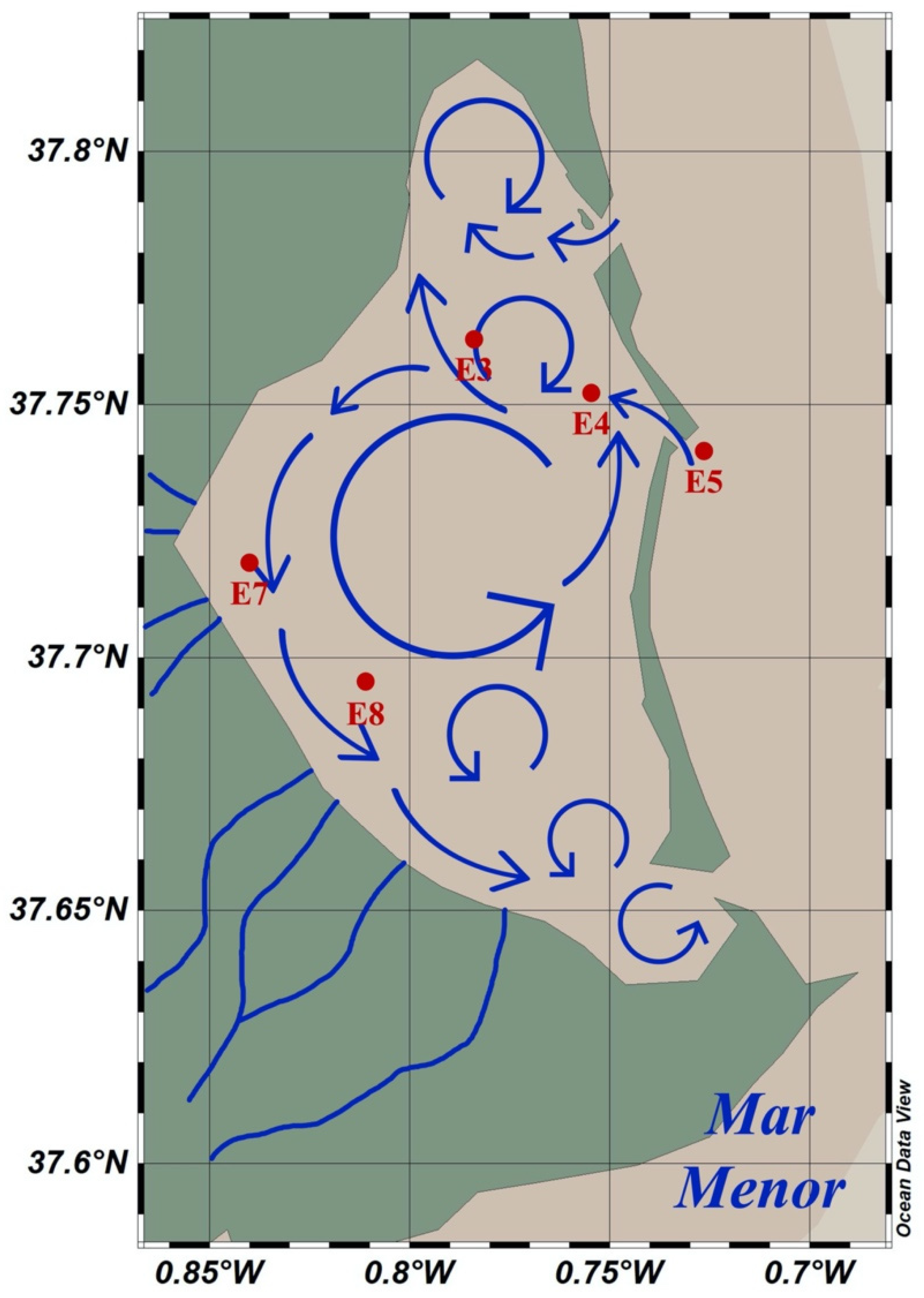
5. Conclusions
Author Contributions
Funding
Institutional Review Board Statement
Informed Consent Statement
Data Availability Statement
Acknowledgments
Conflicts of Interest
References
- IPCC Climate Change 2021: The Physical Science Basis. Working Group I Contribution to the IPCC Sixth Assessment Report; Cambridge University Press: Cambridge, UK; New York, NY, USA, 2021; p. 2391. [CrossRef]
- Ahmed, M. Introduction to Modern Climate Change. Andrew E. Dessler: Cambridge University Press, 2011, 252 pp, ISBN-10: 0521173159. Sci. Total Environ. 2020, 734, 139397. [Google Scholar] [CrossRef]
- UNCCS Climate Action and Support Trends; United Nations Climate Change Secretariat: Bonn, Germany, 2019; 34p, Available online: https://unfccc.int/sites/default/files/resource/Climate_Action_Support_Trends_2019.pdf (accessed on 25 July 2022).
- Fawzy, S.; Osman, A.I.; Doran, J.; Rooney, D.W. Strategies for Mitigation of Climate Change: A Review. Environ. Chem. Lett. 2020, 18, 2069–2094. [Google Scholar] [CrossRef]
- Bates, B.C.; Kundzewicz, Z.; Wu, S.; Palutikof, J. Climate Change and Water; Bates, B.C., Kundzewicz, Z., Wu, S., Palutikof, J., Eds.; Technical; IPCC Secretariat: Geneva, Switzerland, 2008; ISBN 9789291691234. [Google Scholar]
- Longobardi, A.; Villani, P. Trend Analysis of Annual and Seasonal Rainfall Time Series in the Mediterranean Area. Int. J. Climatol. 2010, 30, 1538–1546. [Google Scholar] [CrossRef]
- Benabdelouahab, T.; Gadouali, F.; Boudhar, A.; Lebrini, Y.; Hadria, R.; Salhi, A. Analysis and Trends of Rainfall Amounts and Extreme Events in the Western Mediterranean Region. Theor. Appl. Climatol. 2020, 141, 309–320. [Google Scholar] [CrossRef]
- Achite, M.; Caloiero, T.; Toubal, A.K. Rainfall and Runoff Trend Analysis in the Wadi Mina Basin (Northern Algeria) Using Non-Parametric Tests and the ITA Method. Sustainability 2022, 14, 9892. [Google Scholar] [CrossRef]
- León, V.M.; García, V.; Campillo, J.A. Impact of Flash Flood Events on the Distribution of Organic Pollutants in Surface Sediments from a Mediterranean Coastal Lagoon (Mar Menor, SE Spain). Environ. Sci. Pollut. Res. 2017, 24, 4284–4300. [Google Scholar] [CrossRef]
- Pérez-Ruzafa, A.; Marcos, C.; Pérez-Ruzafa, I.M. Mediterranean Coastal Lagoons in an Ecosystem and Aquatic Resources Management Context. Phys. Chem. Earth 2011, 36, 160–166. [Google Scholar] [CrossRef]
- Tagliapietra, D.; Sigovini, M.; Ghirardini, A.V. A Review of Terms and Definitions to Categorise Estuaries, Lagoons and Associated Environments. Mar. Freshw. Res. 2009, 60, 497–509. [Google Scholar] [CrossRef]
- Pérez-Ruzafa, A.; Pérez-Ruzafa, I.M.; Newton, A.; Marcos, C. Coastal Lagoons: Environmental Variability, Ecosystem Complexity, and Goods and Services Uniformity. In Coasts and Estuaries; Elsevier Inc.: Amsterdam, The Netherlands, 2019; pp. 253–276. ISBN 9780128140048. [Google Scholar]
- Pérez-Ruzafa, A.; Fernández, A.I.; Marcos, C.; Gilabert, J.; Quispe, J.I.; García-Charton, J.A. Spatial and Temporal Variations of Hydrological Conditions, Nutrients and Chlorophyll a in a Mediterranean Coastal Lagoon (Mar Menor, Spain). Hydrobiologia 2005, 550, 11–27. [Google Scholar] [CrossRef]
- Pérez-Ruzafa, Á.; Marcos, C.; Gilabert, J. The Ecology Of The Mar Menor Coastal Lagoon: A Fast Changing Ecosystem Under Human Pressure. In Coastal Lagoons. Ecosystem Processes and Modeling for Sustainable Use and Development; Gönenç, I.E., Wolflin, J.P., Eds.; CRC Press: Boca Raton, FL, USA, 2005; pp. 392–422. [Google Scholar]
- Erena, M.; Domínguez, J.A.; Aguado-Giménez, F.; Soria, J.; García-Galiano, S. Monitoring Coastal Lagoon Water Quality through Remote Sensing: The Mar Menor as a Case Study. Water 2019, 11, 1468. [Google Scholar] [CrossRef] [Green Version]
- Bayo, J.; Rojo, D.; Olmos, S. Abundance, Morphology and Chemical Composition of Microplastics in Sand and Sediments from a Protected Coastal Area: The Mar Menor Lagoon (SE Spain). Environ. Pollut. 2019, 252, 1357–1366. [Google Scholar] [CrossRef] [PubMed]
- Pérez-Ruzafa, A.; Campillo, S.; Fernández-Palacios, J.M.; García-Lacunza, A.; García-Oliva, M.; Ibañez, H.; Navarro-Martínez, P.C.; Pérez-Marcos, M.; Pérez-Ruzafa, I.M.; Quispe-Becerra, J.I.; et al. Long-Term Dynamic in Nutrients, Chlorophyll a, and Water Quality Parameters in a Coastal Lagoon during a Process of Eutrophication for Decades, a Sudden Break and a Relatively Rapid Recovery. Front. Mar. Sci. 2019, 6, 26. [Google Scholar] [CrossRef] [Green Version]
- Ghezzo, M.; De Pascalis, F.; Umgiesser, G.; Zemlys, P.; Sigovini, M.; Marcos, C.; Pérez-Ruzafa, A. Connectivity in Three European Coastal Lagoons. Estuaries Coasts 2015, 38, 1764–1781. [Google Scholar] [CrossRef]
- Peñalver, R.; Ortiz, A.; Arroyo-Manzanares, N.; Campillo, N.; López-García, I.; Viñas, P. Non-Targeted Analysis by DLLME-GC-MS for the Monitoring of Pollutants in the Mar Menor Lagoon. Chemosphere 2022, 286, 131588. [Google Scholar] [CrossRef]
- Garcia-Ayllon, S.; Radke, J. Geostatistical Analysis of the Spatial Correlation between Territorial Anthropization and Flooding Vulnerability: Application to the DANA Phenomenon in a Mediterranean Watershed. Appl. Sci. 2021, 11, 809. [Google Scholar] [CrossRef]
- Pastor, F.; Valiente, J.A.; Palau, J.L. Sea Surface Temperature in the Mediterranean: Trends and Spatial Patterns (1982–2016). Pure Appl. Geophys. 2018, 175, 4017–4029. [Google Scholar] [CrossRef] [Green Version]
- Schlitzer, R. Ocean Data View 2022. Available online: https://odv.awi.de (accessed on 1 July 2022).
- Brasseur, P.; Beckers, J.M.; Brankart, J.M.; Schoenauen, R. Seasonal Temperature and Salinity Fields in the Mediterranean Sea: Climatological Analyses of a Historical Data Set. Deep. Res. I 1996, 43, 159–192. [Google Scholar] [CrossRef]
- Grilli, F.; Accoroni, S.; Acri, F.; Aubry, F.B.; Bergami, C.; Cabrini, M.; Campanelli, A.; Giani, M.; Guicciardi, S.; Marini, M.; et al. Seasonal and Interannual Trends of Oceanographic Parameters over 40 Years in the Northern Adriatic Sea in Relation to Nutrient Loadings Using the EMODnet Chemistry Data Portal. Water 2020, 12, 2280. [Google Scholar] [CrossRef]
- Marini, M.; Frapiccini, E. Do Lagoon Area Sediments Act as Traps for Polycyclic Aromatic Hydrocarbons? Chemosphere 2014, 111, 80–88. [Google Scholar] [CrossRef] [PubMed]
- Frapiccini, E.; Marini, M. Polycyclic Aromatic Hydrocarbon Degradation and Sorption Parameters in Coastal and Open-Sea Sediment. Water Air Soil Pollut. 2015, 226, 246. [Google Scholar] [CrossRef]
- Fernández-alías, A.; Montaño-barroso, T.; Manchado-pérez, S.; López-galindo, C.; Marcos, C.; Pérez-ruzafa, A. Nutrient Overload Promotes the Transition from Top-down to Bottom-up Control and Triggers Dystrophic Crises in a Mediterranean Coastal Lagoon. Sci. Total Environ. 2022, 846, 157388. [Google Scholar] [CrossRef] [PubMed]
- Burkholder, J.A.M.; Tomasko, D.A.; Touchette, B.W. Seagrasses and Eutrophication. J. Exp. Mar. Biol. Ecol. 2007, 350, 46–72. [Google Scholar] [CrossRef]
- Ricci, F.; Capellacci, S.; Campanelli, A.; Grilli, F.; Marini, M.; Penna, A. Long-Term Dynamics of Annual and Seasonal Physical and Biogeochemical Properties: Role of Minor River Discharges in the North-Western Adriatic Coast. Estuar. Coast. Shelf Sci. 2022, 272, 107902. [Google Scholar] [CrossRef]
- Morabito, G.; Mazzocchi, M.G.; Salmaso, N.; Zingone, A.; Bergami, C.; Flaim, G.; Accoroni, S.; Basset, A.; Bastianini, M.; Belmonte, G.; et al. Plankton Dynamics across the Freshwater, Transitional and Marine Research Sites of the LTER-Italy Network. Patterns, Fluctuations, Drivers. Sci. Total Environ. 2018, 627, 373–387. [Google Scholar] [CrossRef]
- Chaffin, J.D.; Kane, D.D.; Stanislawczyk, K.; Parker, E.M. Accuracy of Data Buoys for Measurement of Cyanobacteria, Chlorophyll, and Turbidity in a Large Lake (Lake Erie, North America): Implications for Estimation of Cyanobacterial Bloom Parameters from Water Quality Sonde Measurements. Environ. Sci. Pollut. Res. 2018, 25, 25175–25189. [Google Scholar] [CrossRef]
- Hull, V.; Parrella, L.; Falcucci, M. Modelling Dissolved Oxygen Dynamics in Coastal Lagoons. Ecol. Model. 2008, 211, 468–480. [Google Scholar] [CrossRef]
- Macur, R.E.; Jackson, C.R.; Botero, L.M.; McDermott, T.R.; Inskeep, W.P. Bacterial Populations Associated with the Oxidation and Reduction of Arsenic in an Unsaturated Soil. Environ. Sci. Technol. 2004, 38, 104–111. [Google Scholar] [CrossRef]
- Boyer, T.; Conkright, M.E.; Levitus, S. Seasonal Variability of Dissolved Oxygen, Percent Oxygen Saturation, and Apparent Oxygen Utilization in the Atlantic and Pacific Oceans. Deep. Res. Part I Oceanogr. Res. Pap. 1999, 46, 1593–1613. [Google Scholar] [CrossRef]
- García-Oliva, M.; Pérez-Ruzafa, Á.; Umgiesser, G.; McKiver, W.; Ghezzo, M.; De Pascalis, F.; Marcos, C. Assessing the Hydrodynamic Response of the Mar Menor Lagoon to Dredging Inlets Interventions through Numerical Modelling. Water 2018, 10, 959. [Google Scholar] [CrossRef]
- Fernández-Alías, A.; Marcos, C.; Quispe, J.I.; Sabah, S.; Pérez-Ruzafa, A. Population Dynamics and Growth in Three Scyphozoan Jellyfishes, and Their Relationship with Environmental Conditions in a Coastal Lagoon. Estuar. Coast. Shelf Sci. 2020, 243, 106901. [Google Scholar] [CrossRef]
- Malta, E.J.; Stigter, T.Y.; Pacheco, A.; Dill, A.C.; Tavares, D.; Santos, R. Effects of External Nutrient Sources and Extreme Weather Events on the Nutrient Budget of a Southern European Coastal Lagoon. Estuaries Coasts 2017, 40, 419–436. [Google Scholar] [CrossRef] [Green Version]
- Neves, R.A.F.; Santos, L.N. Short-Term Effects of Very Heavy Rainfall Events on the Water Quality of a Shallow Coastal Lagoon. Hydrobiologia 2021, 849, 3947–3961. [Google Scholar] [CrossRef]
- Chigbu, P.; Gordon, S.; Strange, T. Influence of Inter-Annual Variations in Climatic Factors on Fecal Coliform Levels in Mississippi Sound. Water Res. 2004, 38, 4341–4352. [Google Scholar] [CrossRef] [PubMed]
- Chapman, P.M. Management of Coastal Lagoons under Climate Change. Estuar. Coast. Shelf Sci. 2012, 110, 32–35. [Google Scholar] [CrossRef]
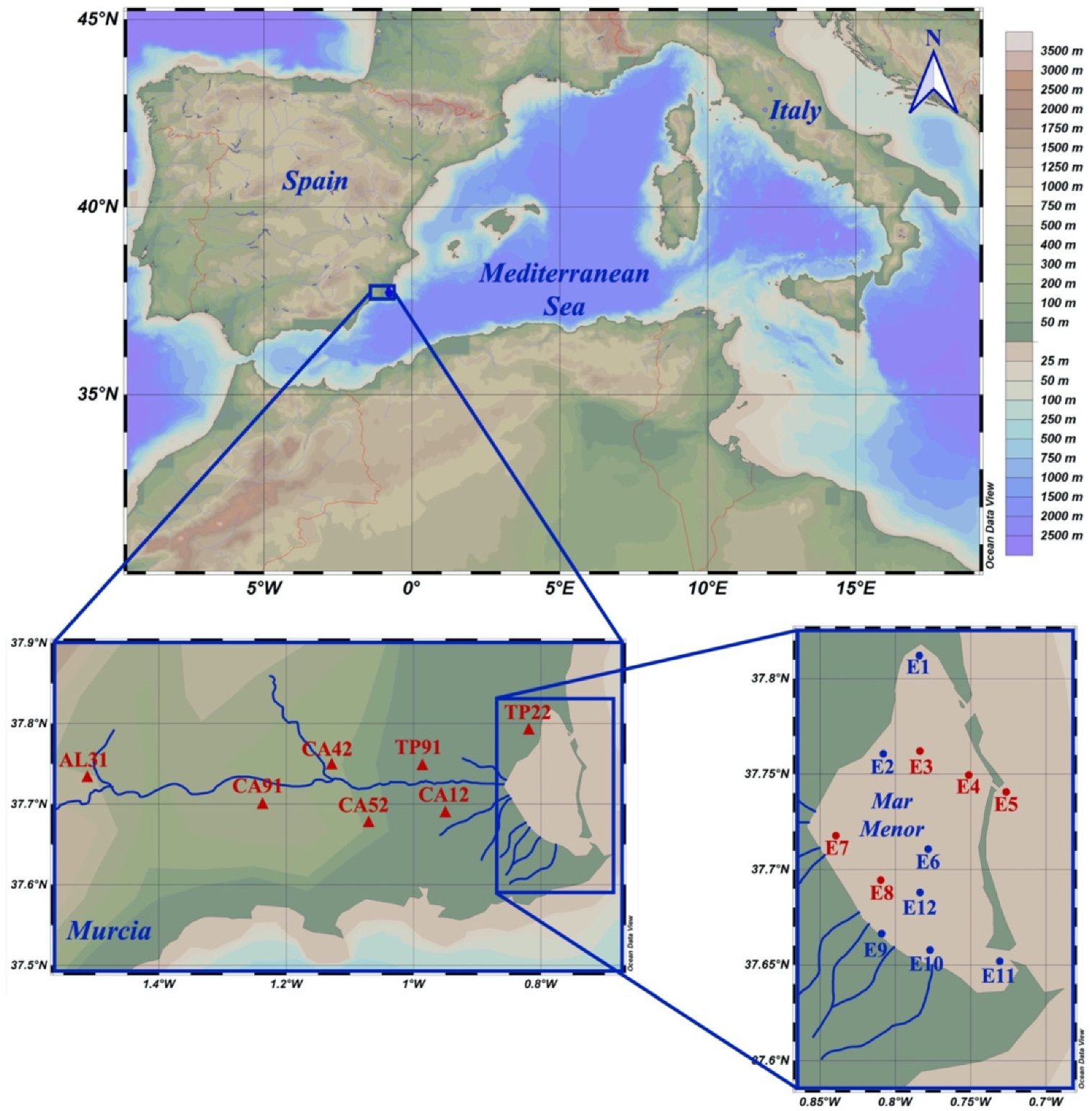
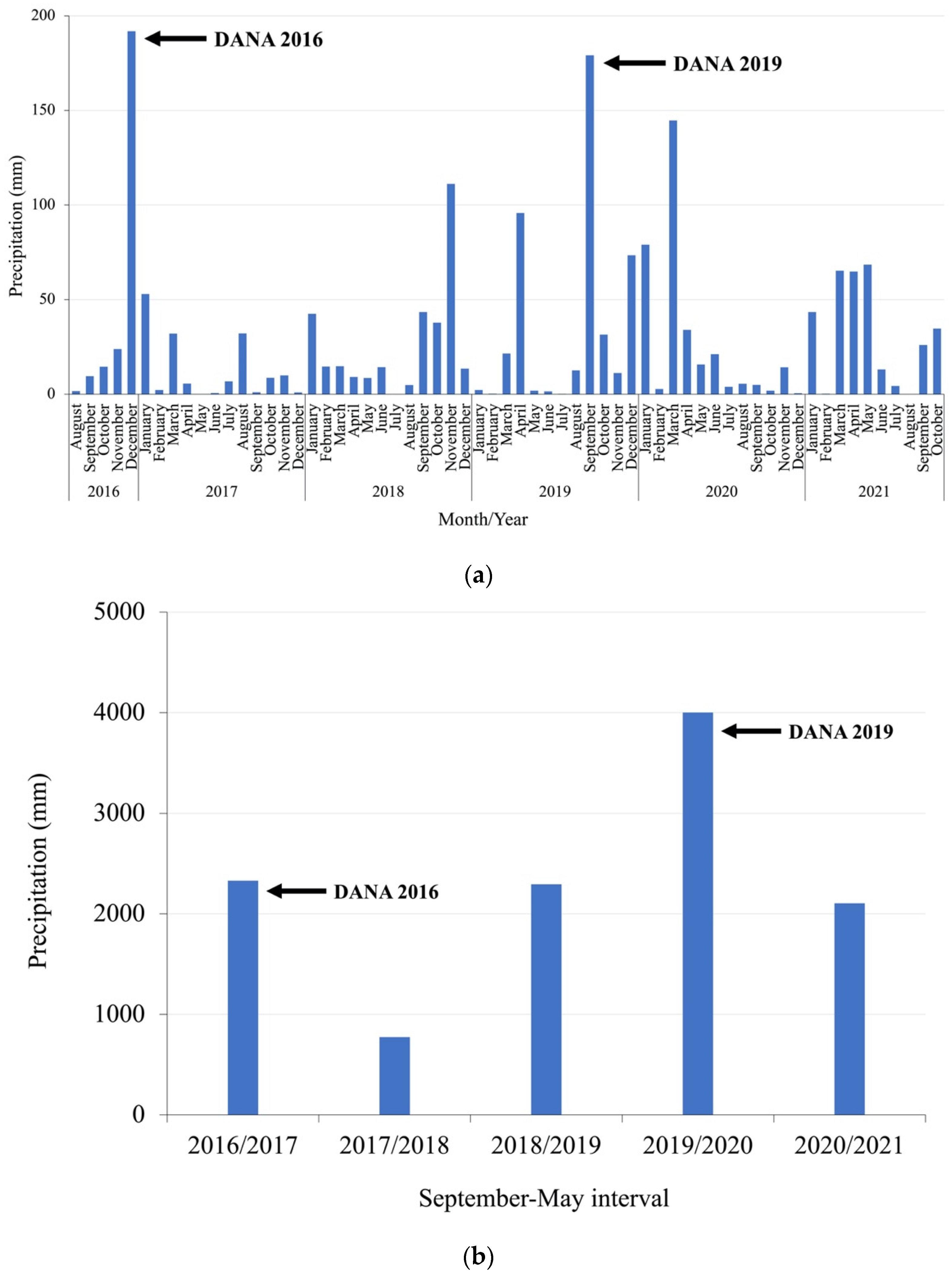
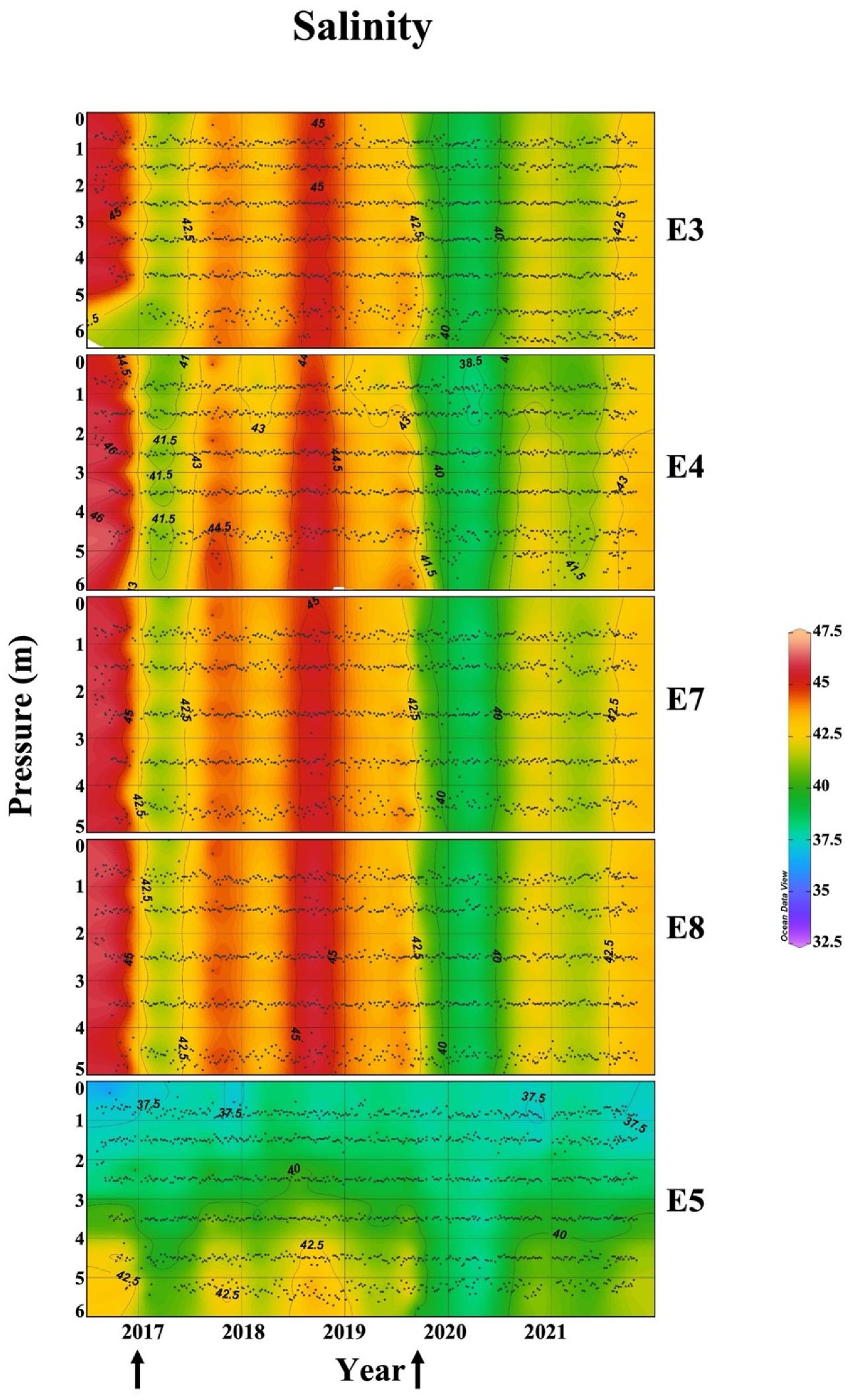

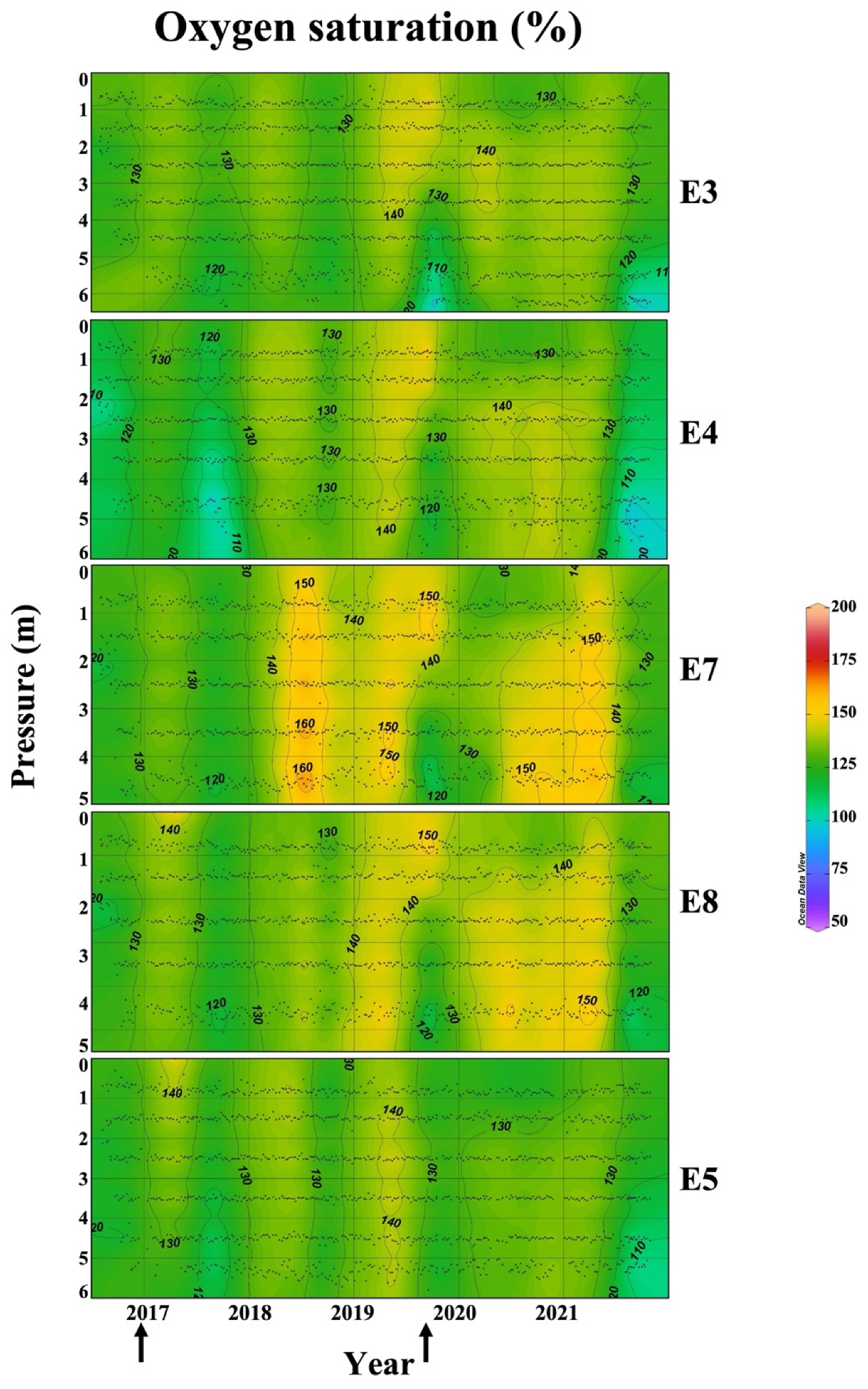


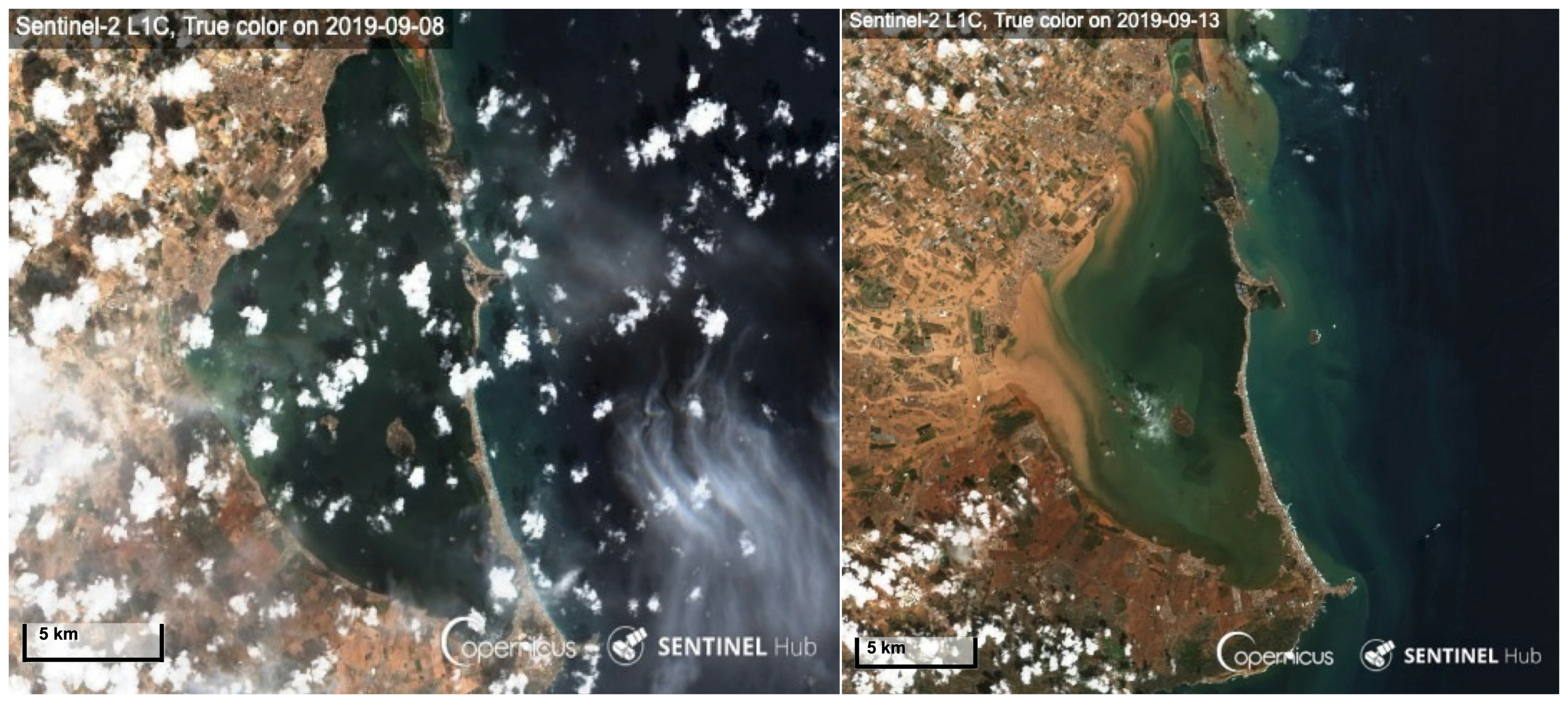
| Rainfall | Chlorophyll | Turbidity | Salinity | Oxygen Saturation | ||||||
|---|---|---|---|---|---|---|---|---|---|---|
| r | r2 | r | r2 | r | r2 | r | r2 | r | r2 | |
| Chlorophyll | 0.250 | 0.063 | ||||||||
| Turbidity | 0.390 | 0.152 | 0.636 | 0.404 | ||||||
| Salinity | −0.120 | 0.014 | −0.020 | 0.000 | −0.136 | 0.018 | ||||
| O2Sat | 0.100 | 0.010 | −0.178 | 0.032 | −0.365 | 0.133 | −0.0253 | 0.001 | ||
| Density | 0.131 | 0.017 | 0.132 | 0.017 | −0.048 | 0.002 | 0.453 | 0.205 | 0.166 | 0.028 |
Publisher’s Note: MDPI stays neutral with regard to jurisdictional claims in published maps and institutional affiliations. |
© 2022 by the authors. Licensee MDPI, Basel, Switzerland. This article is an open access article distributed under the terms and conditions of the Creative Commons Attribution (CC BY) license (https://creativecommons.org/licenses/by/4.0/).
Share and Cite
Machado Toffolo, M.; Grilli, F.; Prandi, C.; Goffredo, S.; Marini, M. Extreme Flooding Events in Coastal Lagoons: Seawater Parameters and Rainfall over A Six-Year Period in the Mar Menor (SE Spain). J. Mar. Sci. Eng. 2022, 10, 1521. https://doi.org/10.3390/jmse10101521
Machado Toffolo M, Grilli F, Prandi C, Goffredo S, Marini M. Extreme Flooding Events in Coastal Lagoons: Seawater Parameters and Rainfall over A Six-Year Period in the Mar Menor (SE Spain). Journal of Marine Science and Engineering. 2022; 10(10):1521. https://doi.org/10.3390/jmse10101521
Chicago/Turabian StyleMachado Toffolo, Mariana, Federica Grilli, Catia Prandi, Stefano Goffredo, and Mauro Marini. 2022. "Extreme Flooding Events in Coastal Lagoons: Seawater Parameters and Rainfall over A Six-Year Period in the Mar Menor (SE Spain)" Journal of Marine Science and Engineering 10, no. 10: 1521. https://doi.org/10.3390/jmse10101521
APA StyleMachado Toffolo, M., Grilli, F., Prandi, C., Goffredo, S., & Marini, M. (2022). Extreme Flooding Events in Coastal Lagoons: Seawater Parameters and Rainfall over A Six-Year Period in the Mar Menor (SE Spain). Journal of Marine Science and Engineering, 10(10), 1521. https://doi.org/10.3390/jmse10101521










